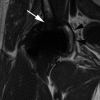Silent soft tissue pathology is common with a modern metal-on-metal hip arthroplasty
- PMID: 21504335
- PMCID: PMC3235307
- DOI: 10.3109/17453674.2011.579518
Silent soft tissue pathology is common with a modern metal-on-metal hip arthroplasty
Abstract
Background and purpose: Adverse reactions to metal debris have been reported to be a cause of pain in metal-on-metal hip arthroplasty. We assessed the incidence of both symptomatic and asymptomatic adverse reactions in a consecutive series of patients with a modern large-head metal-on-metal hip arthroplasty.
Methods: We studied the early clinical results and results of routine metal artifact-reduction MRI screening in a series of 79 large-head metal-on-metal hip arthroplasties (ASR; DePuy, Leeds, UK) in 68 patients. 75 hips were MRI scanned at mean 31 (12-52) months after surgery.
Results: 27 of 75 hips had MRI-detected metal debris-related abnormalities, of which 5 were mild, 18 moderate, and 4 severe. 8 of these hips have been revised, 6 of which were revised for an adverse reaction to metal debris, diagnosed preoperatively with MRI and confirmed histologically. The mean Oxford hip score (OHS) for the whole cohort was 21. It was mean 23 for patients with no MRI-based evidence of adverse reactions and 19 for those with adverse reactions detected by MRI. 6 of 12 patients with a best possible OHS of 12 had MRI-based evidence of an adverse reaction.
Interpretation: We have found a high early revision rate with a modern, large-head metal-on-metal hip arthroplasty. MRI-detected adverse rections to metal debris was common and often clinically "silent". We recommend that patients with this implant should be closely followed up and undergo routine metal artifact-reduction MRI screening.
Figures



References
-
- Amstutz HC, Grigoris P. Metal on metal bearings in hip arthroplasty. Clin Orthop (Suppl) 1996;((329)):S11–34. - PubMed
-
- Amstutz HC, Beaule PE, Dorey FJ, Le Duff MJ, Campbell PA, Gruen TA. Metal-on-metal hybrid surface arthroplasty: two to six-year follow-up study. J Bone Joint Surg (Am) 2004;86((1)):28–39. - PubMed
-
- Anderson H, Toms AP, Cahir JG, Goodwin RW, Wimhurst J, Nolan JF. Grading the severity of soft tissue changes associated with metal-on-metal hip replacements: reliability of an MR grading system. Skeletal Radiol. 2011;40((3)):303–7. - PubMed
-
- Australian Orthopaedic Association National Joint Replacement Registry Adelaide: AOA; 2009. Annual Report.
-
- Beaule PE, Dorey FJ, LeDuff M, Gruen T, Amstutz HC. Risk factors affecting outcome of metal-on-metal surface arthroplasty of the hip. Clin Orthop. 2004;((418)):87–93. - PubMed
MeSH terms
Substances
LinkOut - more resources
Full Text Sources
Medical
